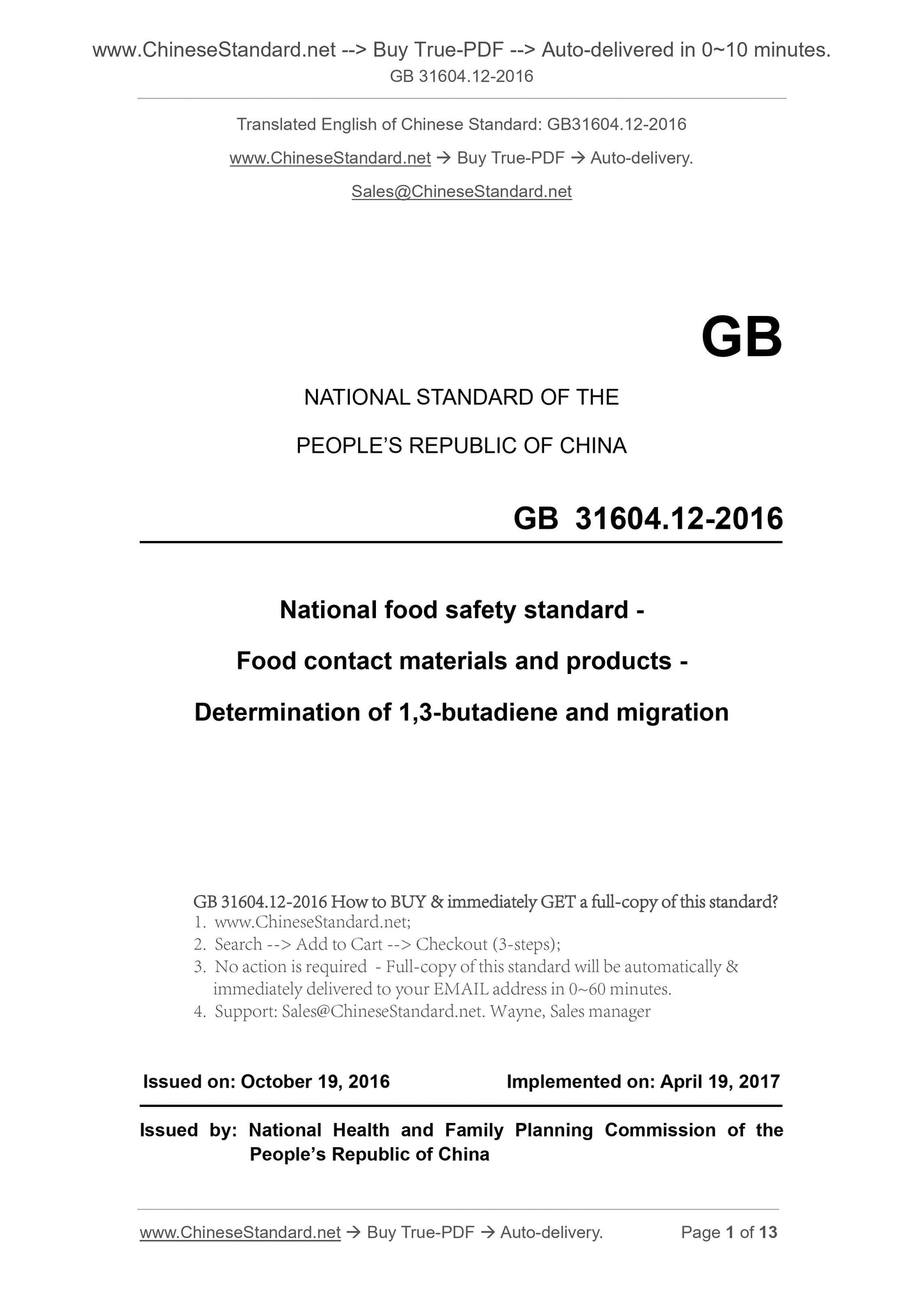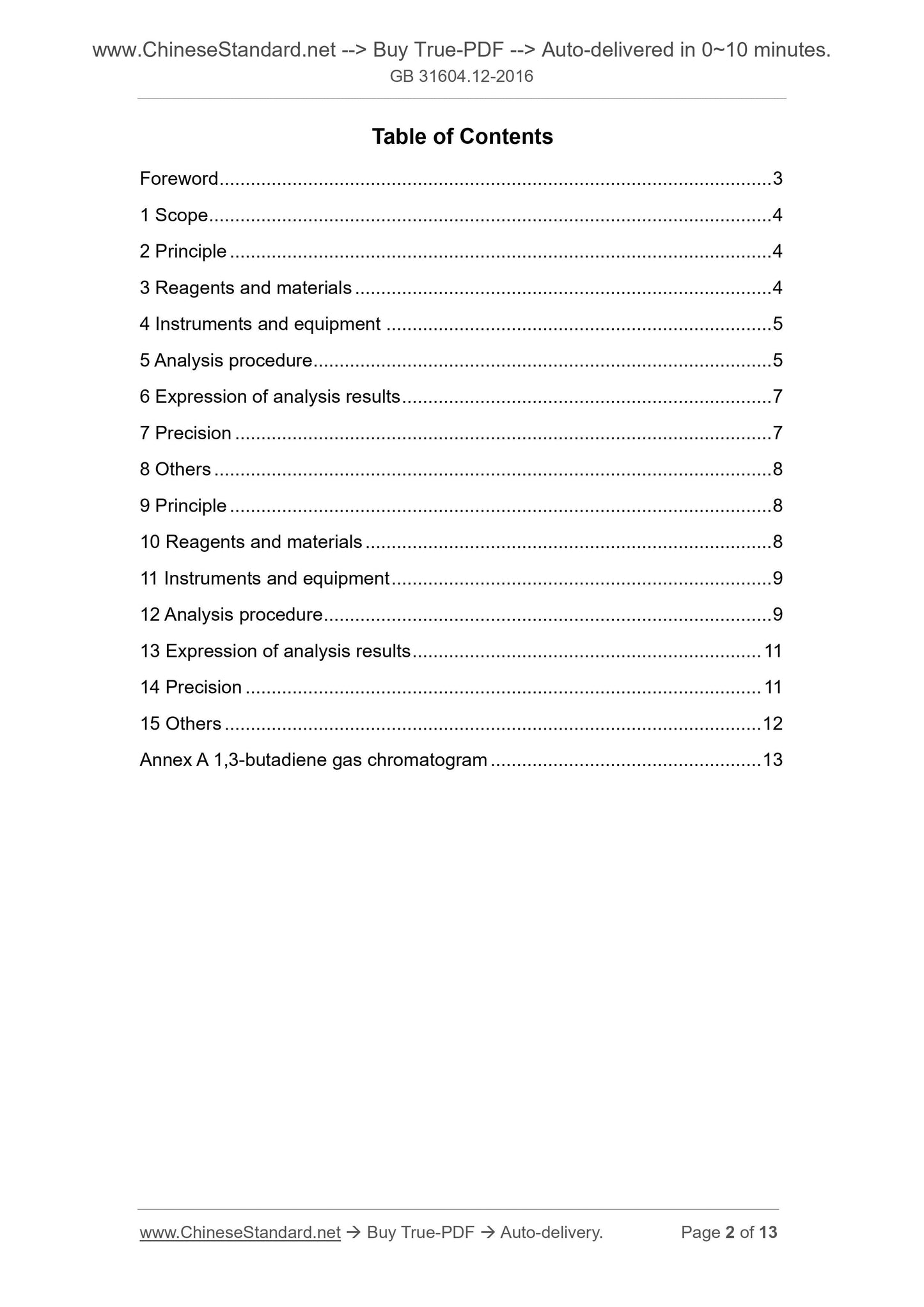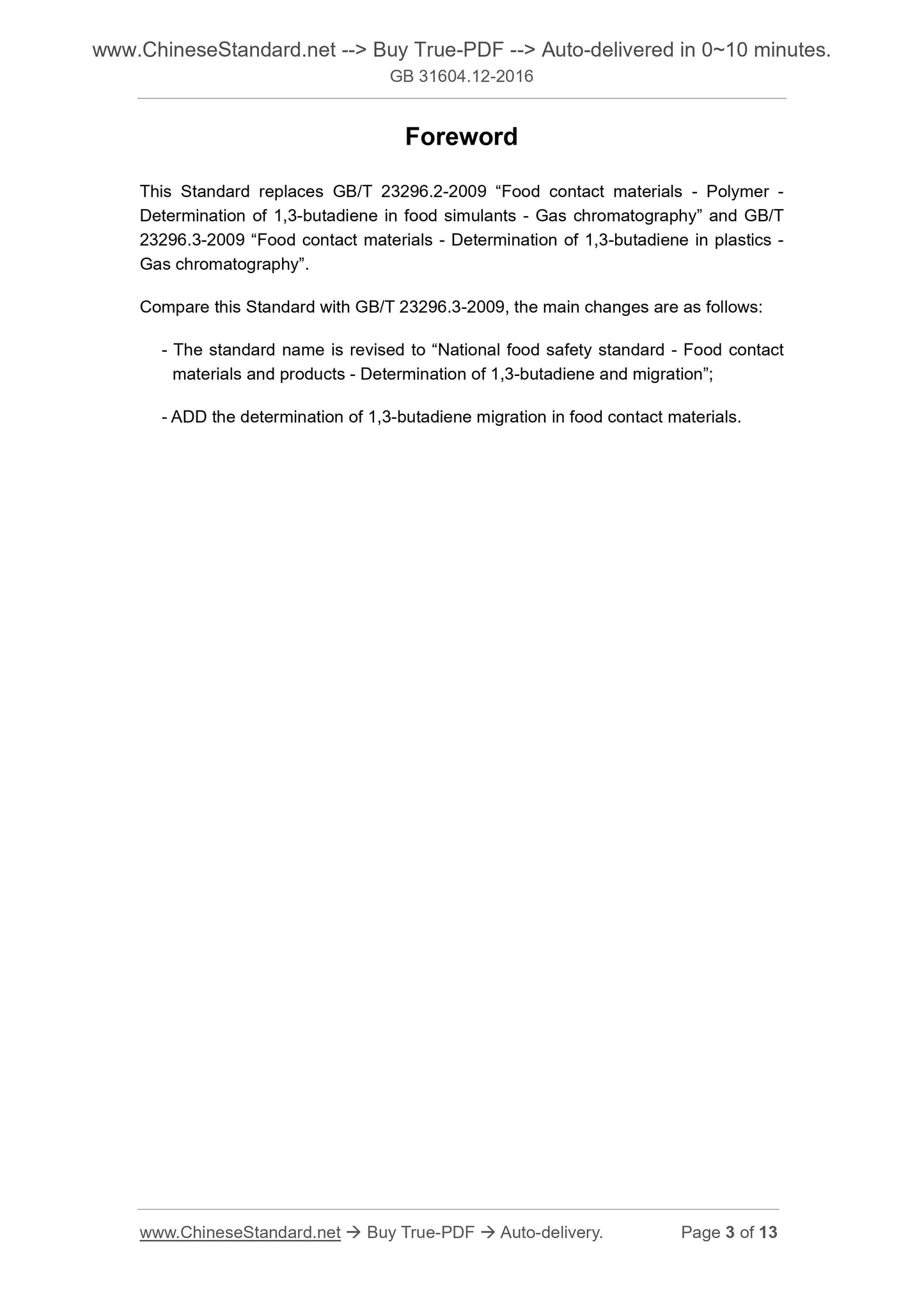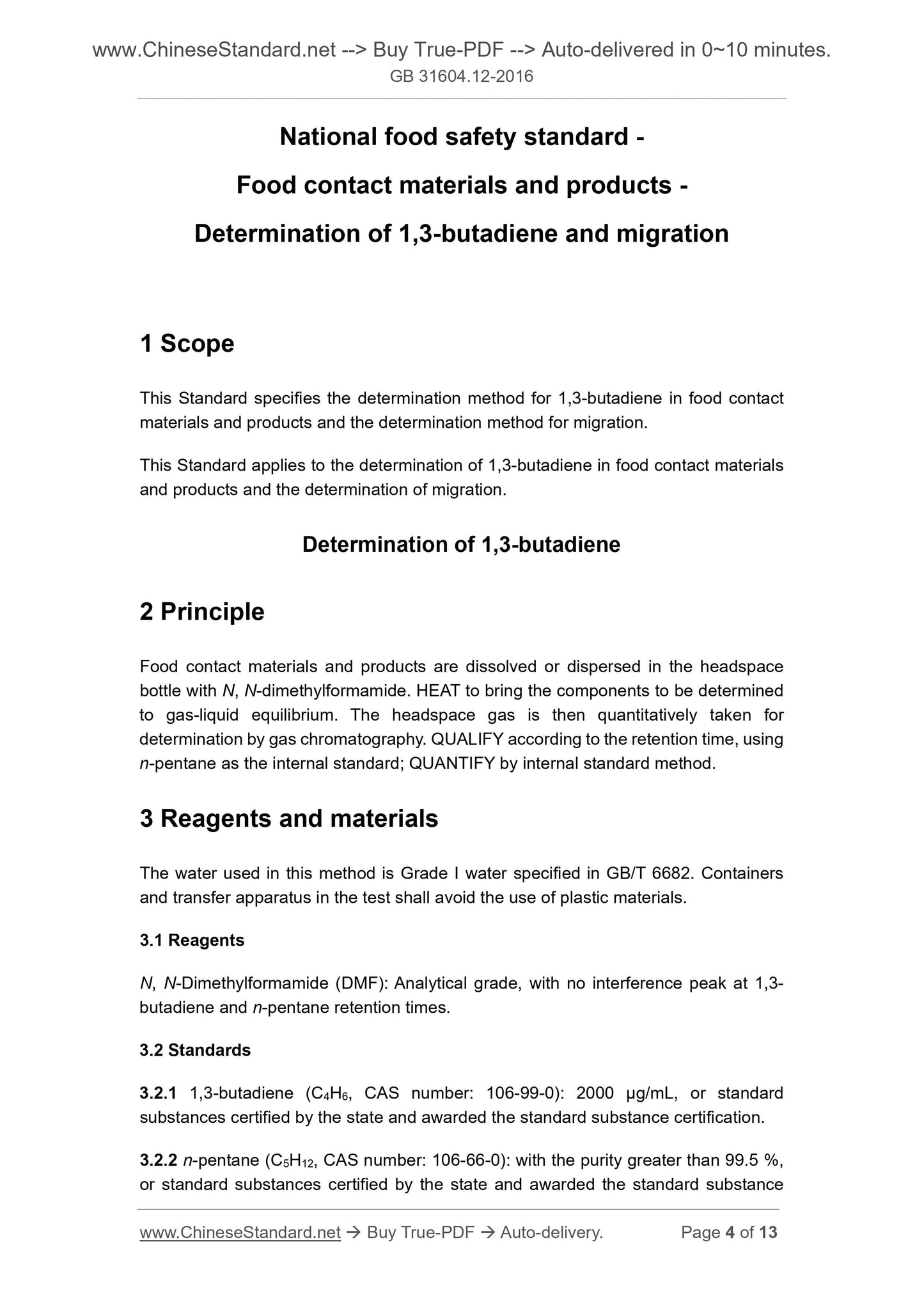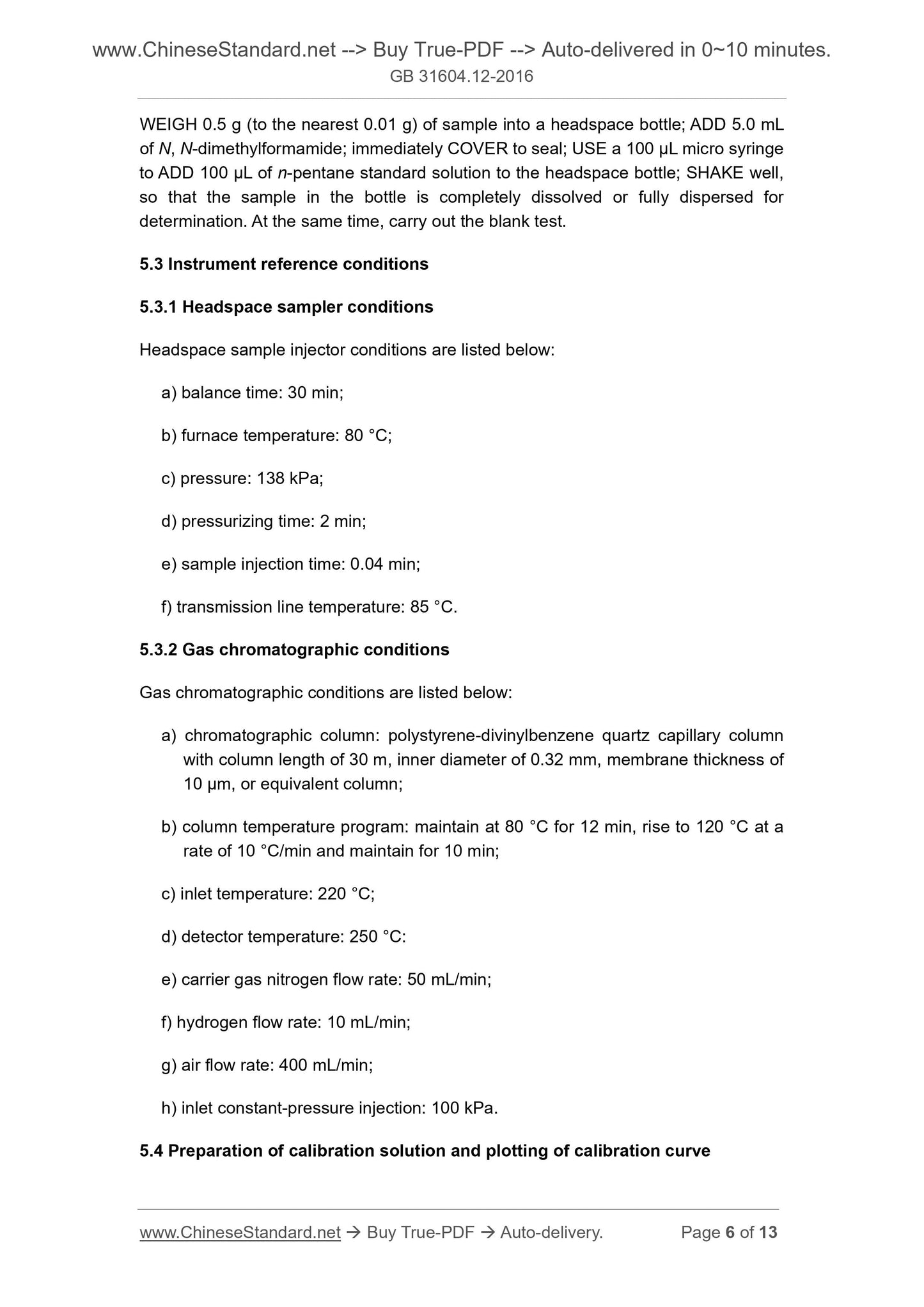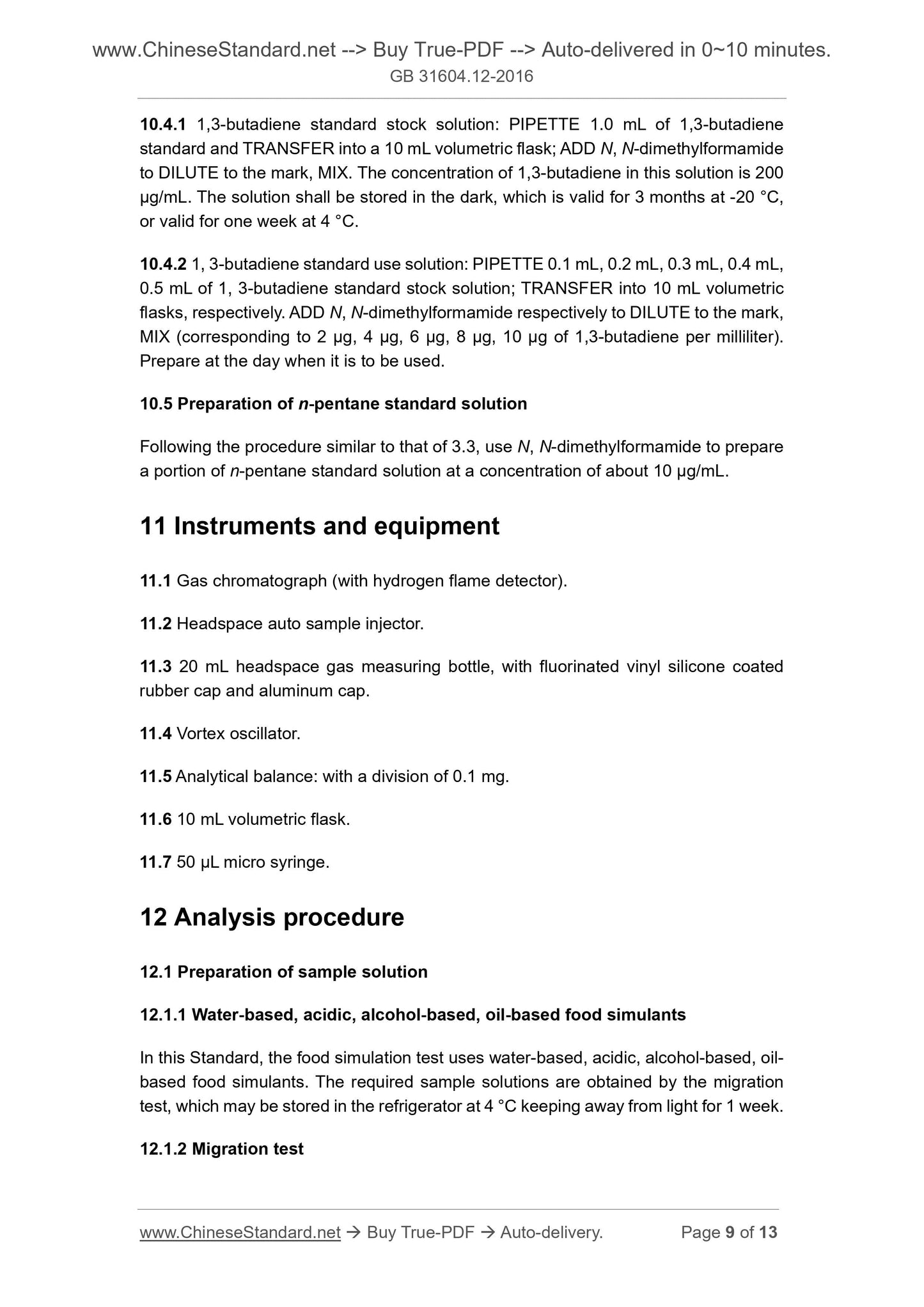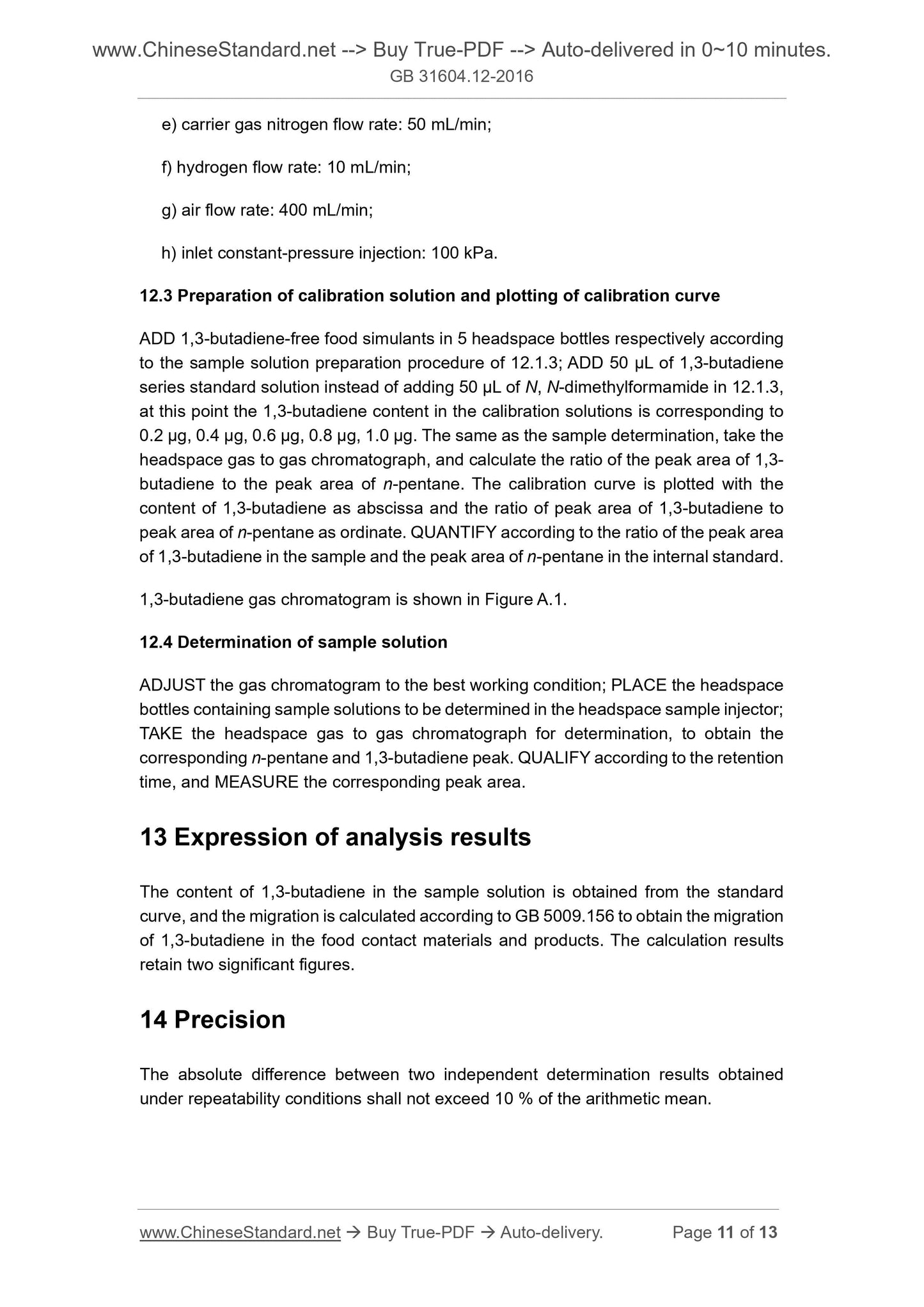1
/
of
7
PayPal, credit cards. Download editable-PDF & invoice in 1 second!
GB 31604.12-2016 English PDF
GB 31604.12-2016 English PDF
Regular price
$75.00 USD
Regular price
Sale price
$75.00 USD
Unit price
/
per
Shipping calculated at checkout.
Couldn't load pickup availability
Delivery: 3 seconds. Download true-PDF + Invoice.
Get QUOTATION in 1-minute: Click GB 31604.12-2016
Historical versions: GB 31604.12-2016
Preview True-PDF (Reload/Scroll if blank)
GB 31604.12-2016: Food contact materials -- Polymer -- Determination of 1, 3-butadiene in food simulants -- Gas chromatography
GB 31604.12-2016
GB
NATIONAL STANDARD OF THE
PEOPLE’S REPUBLIC OF CHINA
National food safety standard -
Food contact materials and products -
Determination of 1,3-butadiene and migration
ISSUED ON. OCTOBER 19, 2016
IMPLEMENTED ON. APRIL 19, 2017
Issued by. National Health and Family Planning Commission of the
People’s Republic of China
Table of Contents
Foreword ... 3
1 Scope ... 4
2 Principle ... 4
3 Reagents and materials ... 4
4 Instruments and equipment ... 5
5 Analysis procedure ... 5
6 Expression of analysis results ... 7
7 Precision ... 7
8 Others ... 8
9 Principle ... 8
10 Reagents and materials ... 8
11 Instruments and equipment ... 9
12 Analysis procedure ... 9
13 Expression of analysis results ... 11
14 Precision ... 11
15 Others ... 12
Annex A 1,3-butadiene gas chromatogram ... 13
Foreword
This Standard replaces GB/T 23296.2-2009 “Food contact materials - Polymer -
Determination of 1,3-butadiene in food simulants - Gas chromatography” and GB/T
23296.3-2009 “Food contact materials - Determination of 1,3-butadiene in plastics -
Gas chromatography”.
Compare this Standard with GB/T 23296.3-2009, the main changes are as follows.
- The standard name is revised to “National food safety standard - Food contact
materials and products - Determination of 1,3-butadiene and migration”;
- ADD the determination of 1,3-butadiene migration in food contact materials.
National food safety standard -
Food contact materials and products -
Determination of 1,3-butadiene and migration
1 Scope
This Standard specifies the determination method for 1,3-butadiene in food contact
materials and products and the determination method for migration.
This Standard applies to the determination of 1,3-butadiene in food contact materials
and products and the determination of migration.
Determination of 1,3-butadiene
2 Principle
Food contact materials and products are dissolved or dispersed in the headspace
bottle with N, N-dimethylformamide. HEAT to bring the components to be determined
to gas-liquid equilibrium. The headspace gas is then quantitatively taken for
determination by gas chromatography. QUALIFY according to the retention time, using
n-pentane as the internal standard; QUANTIFY by internal standard method.
3 Reagents and materials
The water used in this method is Grade I water specified in GB/T 6682. Containers
and transfer apparatus in the test shall avoid the use of plastic materials.
3.1 Reagents
N, N-Dimethylformamide (DMF). Analytical grade, with no interference peak at 1,3-
butadiene and n-pentane retention times.
3.2 Standards
3.2.1 1,3-butadiene (C4H6, CAS number. 106-99-0). 2000 μg/mL, or standard
substances certified by the state and awarded the standard substance certification.
3.2.2 n-pentane (C5H12, CAS number. 106-66-0). with the purity greater than 99.5 %,
or standard substances certified by the state and awarded the standard substance
WEIGH 0.5 g (to the nearest 0.01 g) of sample into a headspace bottle; ADD 5.0 mL
of N, N-dimethylformamide; immediately COVER to seal; USE a 100 μL micro syringe
to ADD 100 μL of n-pentane standard solution to the headspace bottle; SHAKE well,
so that the sample in the bottle is completely dissolved or fully dispersed for
determination. At the same time, carry out the blank test.
5.3 Instrument reference conditions
5.3.1 Headspace sampler conditions
Headspace sample injector conditions are listed below.
a) balance time. 30 min;
b) furnace temperature. 80 °C;
c) pressure. 138 kPa;
d) pressurizing time. 2 min;
e) sample injection time. 0.04 min;
f) transmission line temperature. 85 °C.
5.3.2 Gas chromatographic conditions
Gas chromatographic conditions are listed below.
a) chromatographic column. polystyrene-divinylbenzene quartz capillary column
with column length of 30 m, inner diameter of 0.32 mm, membrane thickness of
10 μm, or equivalent column;
b) column temperature program. maintain at 80 °C for 12 min, rise to 120 °C at a
rate of 10 °C/min and maintain for 10 min;
c) inlet temperature. 220 °C;
d) detector temperature. 250 °C.
e) carrier gas nitrogen flow rate. 50 mL/min;
f) hydrogen flow rate. 10 mL/min;
g) air flow rate. 400 mL/min;
h) inlet constant-pressure injection. 100 kPa.
5.4 Preparation of calibration solution and plotting of calibration curve
10.4.1 1,3-butadiene standard stock solution. PIPETTE 1.0 mL of 1,3-butadiene
standard and TRANSFER into a 10 mL volumetric flask; ADD N, N-dimethylformamide
to DILUTE to the mark, MIX. The concentration of 1,3-butadiene in this solution is 200
μg/mL. The solution shall be stored in the dark, which is valid for 3 months at -20 °C,
or valid for one week at 4 °C.
10.4.2 1, 3-butadiene standard use solution. PIPETTE 0.1 mL, 0.2 mL, 0.3 mL, 0.4 mL,
0.5 mL of 1, 3-butadiene standard stock solution; TRANSFER into 10 mL volumetric
flasks, respectively. ADD N, N-dimethylformamide respectively to DILUTE to the mark,
MIX (corresponding to 2 μg, 4 μg, 6 μg, 8 μg, 10 μg of 1,3-butadiene per milliliter).
Prepare at the day when it is to be used.
10.5 Preparation of n-pentane standard solution
Following the procedure similar to that of 3.3, use N, N-dimethylformamide to prepare
a portion of n-pentane standard solution at a concentration of about 10 μg/mL.
11 Instruments and equipment
11.1 Gas chromatograph (with hydrogen flame detector).
11.2 Headspace auto sample injector.
11.3 20 mL headspace gas measuring bottle, with fluorinated vinyl silicone coated
rubber cap and aluminum cap.
11.4 Vortex oscillator.
11.5 Analytical balance. with a division of 0.1 mg.
11.6 10 mL volumetric flask.
11.7 50 μL micro syringe.
12 Analysis procedure
12.1 Preparation of sample solution
12.1.1 Water-based, acidic, alcohol-based, oil-based food simulants
In this Standard, the food simulation test uses water-based, acidic, alcohol-based, oil-
based food simulants. The required sample solutions are obtained by the migration
test, which may be stored in the refrigerator at 4 °C keeping away from light for 1 week.
12.1.2 Migration test
e) carrier gas nitrogen flow rate. 50 mL/min;
f) hydrogen flow rate. 10 mL/min;
g) air flow rate. 400 mL/min;
h) inlet constant-pressure injection. 100 kPa.
12.3 Preparation of calibration solution and plotting of calibration curve
ADD 1,3-butadiene-free food simulants in 5 headspace bottles respectively according
to the sample solution preparation procedure of 12.1.3; ADD 50 μL of 1,3-butadiene
series standard solution instead of adding 50 μL of N, N-dimethylformamide in 12.1.3,
at this point the 1,3-butadiene content in the calibration solutions is corresponding to
0.2 μg, 0.4 μg, 0.6 μg, 0.8 μg, 1.0 μg. The same as the sample determination, take the
headspace gas to gas chromatograph, and calculate the ratio of the peak area of 1,3-
butadiene to the peak area of n-pentane. The calibration curve is plotted with the
content of 1,3-butadiene as abscissa and the ratio of peak area of 1,3-butadiene to
peak area of n-pentane as ordinate. QUANTIFY according to the ratio of the peak area
of 1,3-butadiene in the sample and the peak area of n-pentane in the internal standard.
1,3-butadiene gas chromatogram is shown in Figure A.1.
12.4 Determination of sample solution
ADJUST the gas chromatogram to the best working condition; PLACE the headspace
bottles containing sample solutions to be deter...
Get QUOTATION in 1-minute: Click GB 31604.12-2016
Historical versions: GB 31604.12-2016
Preview True-PDF (Reload/Scroll if blank)
GB 31604.12-2016: Food contact materials -- Polymer -- Determination of 1, 3-butadiene in food simulants -- Gas chromatography
GB 31604.12-2016
GB
NATIONAL STANDARD OF THE
PEOPLE’S REPUBLIC OF CHINA
National food safety standard -
Food contact materials and products -
Determination of 1,3-butadiene and migration
ISSUED ON. OCTOBER 19, 2016
IMPLEMENTED ON. APRIL 19, 2017
Issued by. National Health and Family Planning Commission of the
People’s Republic of China
Table of Contents
Foreword ... 3
1 Scope ... 4
2 Principle ... 4
3 Reagents and materials ... 4
4 Instruments and equipment ... 5
5 Analysis procedure ... 5
6 Expression of analysis results ... 7
7 Precision ... 7
8 Others ... 8
9 Principle ... 8
10 Reagents and materials ... 8
11 Instruments and equipment ... 9
12 Analysis procedure ... 9
13 Expression of analysis results ... 11
14 Precision ... 11
15 Others ... 12
Annex A 1,3-butadiene gas chromatogram ... 13
Foreword
This Standard replaces GB/T 23296.2-2009 “Food contact materials - Polymer -
Determination of 1,3-butadiene in food simulants - Gas chromatography” and GB/T
23296.3-2009 “Food contact materials - Determination of 1,3-butadiene in plastics -
Gas chromatography”.
Compare this Standard with GB/T 23296.3-2009, the main changes are as follows.
- The standard name is revised to “National food safety standard - Food contact
materials and products - Determination of 1,3-butadiene and migration”;
- ADD the determination of 1,3-butadiene migration in food contact materials.
National food safety standard -
Food contact materials and products -
Determination of 1,3-butadiene and migration
1 Scope
This Standard specifies the determination method for 1,3-butadiene in food contact
materials and products and the determination method for migration.
This Standard applies to the determination of 1,3-butadiene in food contact materials
and products and the determination of migration.
Determination of 1,3-butadiene
2 Principle
Food contact materials and products are dissolved or dispersed in the headspace
bottle with N, N-dimethylformamide. HEAT to bring the components to be determined
to gas-liquid equilibrium. The headspace gas is then quantitatively taken for
determination by gas chromatography. QUALIFY according to the retention time, using
n-pentane as the internal standard; QUANTIFY by internal standard method.
3 Reagents and materials
The water used in this method is Grade I water specified in GB/T 6682. Containers
and transfer apparatus in the test shall avoid the use of plastic materials.
3.1 Reagents
N, N-Dimethylformamide (DMF). Analytical grade, with no interference peak at 1,3-
butadiene and n-pentane retention times.
3.2 Standards
3.2.1 1,3-butadiene (C4H6, CAS number. 106-99-0). 2000 μg/mL, or standard
substances certified by the state and awarded the standard substance certification.
3.2.2 n-pentane (C5H12, CAS number. 106-66-0). with the purity greater than 99.5 %,
or standard substances certified by the state and awarded the standard substance
WEIGH 0.5 g (to the nearest 0.01 g) of sample into a headspace bottle; ADD 5.0 mL
of N, N-dimethylformamide; immediately COVER to seal; USE a 100 μL micro syringe
to ADD 100 μL of n-pentane standard solution to the headspace bottle; SHAKE well,
so that the sample in the bottle is completely dissolved or fully dispersed for
determination. At the same time, carry out the blank test.
5.3 Instrument reference conditions
5.3.1 Headspace sampler conditions
Headspace sample injector conditions are listed below.
a) balance time. 30 min;
b) furnace temperature. 80 °C;
c) pressure. 138 kPa;
d) pressurizing time. 2 min;
e) sample injection time. 0.04 min;
f) transmission line temperature. 85 °C.
5.3.2 Gas chromatographic conditions
Gas chromatographic conditions are listed below.
a) chromatographic column. polystyrene-divinylbenzene quartz capillary column
with column length of 30 m, inner diameter of 0.32 mm, membrane thickness of
10 μm, or equivalent column;
b) column temperature program. maintain at 80 °C for 12 min, rise to 120 °C at a
rate of 10 °C/min and maintain for 10 min;
c) inlet temperature. 220 °C;
d) detector temperature. 250 °C.
e) carrier gas nitrogen flow rate. 50 mL/min;
f) hydrogen flow rate. 10 mL/min;
g) air flow rate. 400 mL/min;
h) inlet constant-pressure injection. 100 kPa.
5.4 Preparation of calibration solution and plotting of calibration curve
10.4.1 1,3-butadiene standard stock solution. PIPETTE 1.0 mL of 1,3-butadiene
standard and TRANSFER into a 10 mL volumetric flask; ADD N, N-dimethylformamide
to DILUTE to the mark, MIX. The concentration of 1,3-butadiene in this solution is 200
μg/mL. The solution shall be stored in the dark, which is valid for 3 months at -20 °C,
or valid for one week at 4 °C.
10.4.2 1, 3-butadiene standard use solution. PIPETTE 0.1 mL, 0.2 mL, 0.3 mL, 0.4 mL,
0.5 mL of 1, 3-butadiene standard stock solution; TRANSFER into 10 mL volumetric
flasks, respectively. ADD N, N-dimethylformamide respectively to DILUTE to the mark,
MIX (corresponding to 2 μg, 4 μg, 6 μg, 8 μg, 10 μg of 1,3-butadiene per milliliter).
Prepare at the day when it is to be used.
10.5 Preparation of n-pentane standard solution
Following the procedure similar to that of 3.3, use N, N-dimethylformamide to prepare
a portion of n-pentane standard solution at a concentration of about 10 μg/mL.
11 Instruments and equipment
11.1 Gas chromatograph (with hydrogen flame detector).
11.2 Headspace auto sample injector.
11.3 20 mL headspace gas measuring bottle, with fluorinated vinyl silicone coated
rubber cap and aluminum cap.
11.4 Vortex oscillator.
11.5 Analytical balance. with a division of 0.1 mg.
11.6 10 mL volumetric flask.
11.7 50 μL micro syringe.
12 Analysis procedure
12.1 Preparation of sample solution
12.1.1 Water-based, acidic, alcohol-based, oil-based food simulants
In this Standard, the food simulation test uses water-based, acidic, alcohol-based, oil-
based food simulants. The required sample solutions are obtained by the migration
test, which may be stored in the refrigerator at 4 °C keeping away from light for 1 week.
12.1.2 Migration test
e) carrier gas nitrogen flow rate. 50 mL/min;
f) hydrogen flow rate. 10 mL/min;
g) air flow rate. 400 mL/min;
h) inlet constant-pressure injection. 100 kPa.
12.3 Preparation of calibration solution and plotting of calibration curve
ADD 1,3-butadiene-free food simulants in 5 headspace bottles respectively according
to the sample solution preparation procedure of 12.1.3; ADD 50 μL of 1,3-butadiene
series standard solution instead of adding 50 μL of N, N-dimethylformamide in 12.1.3,
at this point the 1,3-butadiene content in the calibration solutions is corresponding to
0.2 μg, 0.4 μg, 0.6 μg, 0.8 μg, 1.0 μg. The same as the sample determination, take the
headspace gas to gas chromatograph, and calculate the ratio of the peak area of 1,3-
butadiene to the peak area of n-pentane. The calibration curve is plotted with the
content of 1,3-butadiene as abscissa and the ratio of peak area of 1,3-butadiene to
peak area of n-pentane as ordinate. QUANTIFY according to the ratio of the peak area
of 1,3-butadiene in the sample and the peak area of n-pentane in the internal standard.
1,3-butadiene gas chromatogram is shown in Figure A.1.
12.4 Determination of sample solution
ADJUST the gas chromatogram to the best working condition; PLACE the headspace
bottles containing sample solutions to be deter...
Share
